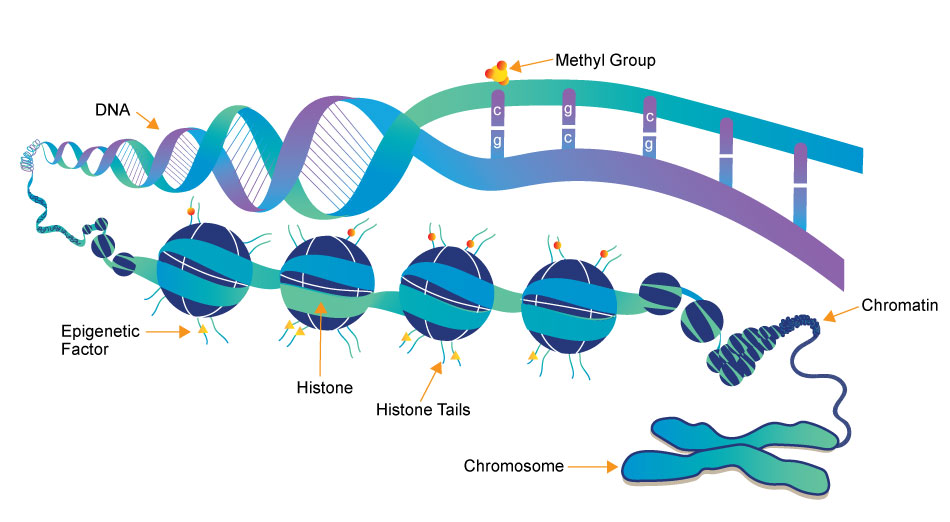Epigenetics


Epigenetics research delves into the molecular mechanisms that control gene expression and cellular traits without altering the underlying DNA sequence. One crucial aspect of this field is the role of small molecules, which act as powerful regulators of epigenetic modifications. These small compounds, typically comprising a few dozen to a few hundred atoms, have emerged as essential tools in understanding and manipulating the epigenome.
- DNA Methylation Inhibitors: Small molecules like 5-azacytidine and 5-aza-2'-deoxycytidine are DNA methyltransferase inhibitors. They block the addition of methyl groups to DNA, leading to DNA demethylation. This can reactivate silenced genes, potentially offering therapeutic avenues for conditions like cancer.
- HDAC inhibitors: HDACs remove acetyl groups from histone proteins, contributing to gene repression. Small molecule HDAC inhibitors, such as Vorinostat and Romidepsin, can reverse this process by increasing histone acetylation, allowing genes to be more accessible for transcription. These inhibitors are being explored for cancer therapy and other conditions.
- Histone Methyltransferase Inhibitors: Small molecules like GSK126 inhibit specific histone methyltransferases, affecting histone methylation patterns. This can alter gene expression, making them promising candidates for cancer and other diseases with epigenetic dysregulation.
- RNA Modulators: Small molecules can also target non-coding RNAs involved in epigenetic regulation. For instance, small molecules called small interfering RNAs (siRNAs) can be designed to target and degrade specific long non-coding RNAs, influencing gene expression.
- Epigenetic Reader Domain Inhibitors: These small molecules target proteins that recognize and bind to specific epigenetic marks. Examples include inhibitors of bromodomain-containing proteins (BET inhibitors), which can disrupt gene regulation by interfering with protein-DNA interactions.
Small molecules in epigenetics research not only provide insights into the fundamental biology of gene regulation but also hold immense promise for developing novel therapeutics. Their ability to selectively modulate specific epigenetic marks and pathways has led to ongoing clinical trials and drug development efforts for various diseases, including cancer, neurological disorders, and inflammatory conditions. Understanding and harnessing the power of these small molecules is at the forefront of modern epigenetics research, offering new hope for precision medicine and targeted therapies.
3 key components involved in the regulation of epigenetic modifications
Epigenetics Writer
Epigenetics writers are enzymes responsible for adding chemical marks or modifications to DNA or histone proteins. These marks include DNA methylation (addition of methyl groups to DNA) and histone modifications (such as acetylation, methylation, phosphorylation, etc.).
Epigenetics Reader
Function: Epigenetics readers are proteins that can recognize and bind to specific epigenetic marks on DNA or histones. These reader proteins interpret the epigenetic code and facilitate downstream cellular processes, such as gene activation or repression.
Epigenetics Eraser
Function: Epigenetics erasers are enzymes responsible for removing or reversing epigenetic marks on DNA or histones. This process allows for the dynamic regulation of gene expression and the resetting of epigenetic states during various stages of development and in response to environmental changes.
-
HDAC 抑制剂
4SC-202 是一种口服生物可利用的苯甲酰胺类化合物,它是人类 I类组蛋白去乙酰化酶(HDACs)同工酶1、2和3的抑制剂,具有潜在的抗肿瘤活性。 -
JAK1 抑制剂
INCB39110 是一种强效的 JAK1 酪氨酸激酶抑制剂,目前正在进行第二阶段试验,用于治疗类风湿性关节炎、骨髓纤维化、类风湿性关节炎和斑块型银屑病。- Czech J, .et al. , Leukemia, 2018, Nov 23 PMID: 30470838
-
Pan-PIM kinase 抑制剂
LGB-321 HCl 是一种强效且选择性的 ATP-竞争性小分子抑制剂,专门针对 PIM激酶(全谱PIM激酶抑制剂)。- Ricardo de Matos Simoes, .et al. , Nat Cancer, 2023, May;4(5):754-773 PMID: 37237081
- Andrea L. Casillas, .et al. , Clin Cancer Res, 2018, Jan 1; 24(1): 169-180 PMID: 29084916
-
JAK 抑制剂
Peficitinib 是一种新型强效的 JAK 抑制剂,在大鼠的佐剂诱导性关节炎模型中显示出强大的疗效。 -
LSD1 抑制剂
SP2509 是一种新型的组蛋白去甲基酶 LSD1 (KDM1A) 拮抗剂,其 IC50 为 13 nM;对 MAO-A 和 MAO-B 无抑制作用。- Ziliang Yu, .et al. , Immunol Res, 2024, May 9 PMID: 38722530
-
JAK 抑制剂
S-Ruxolitinib 是 INCB018424 的手性形式,是一种强效且选择性的小分子 Janus kinase 1 (JAK1) 和 JAK2 抑制剂。 -
JAK 抑制剂
Baricitinib phosphate 是一种选择性的 JAK1 和 JAK2 抑制剂,其 IC50 分别为 5.9 nM 和 5.7 nM,相对于 JAK3 和 Tyk2 的选择性约为70倍和10倍,对 c-Met 和 Chk2 无抑制作用。 -
PARP 抑制剂
BMN-673 (8R,9S) 是 BMN-673 的 (8R,9S) 对映体。BMN 673 是一种新型的 PARP 抑制剂,其 IC50 为 0.58 nM。 -
Pim 抑制剂
CX-6258 hydrochloride hydrate 是一种效力强大的口服 Pim 1/2/3 kinase 抑制剂(IC50=5 nM/25 nM/16 nM),具有出色的生化效力和激酶选择性。 -
JAK 抑制剂
CYT387 硫酸盐是一种 ATP-竞争性抑制剂,针对 JAK1/JAK2 的 IC50 分别为 11 nM/18 nM,相对于 JAK3 具有约10倍的选择性。 -
PARP 抑制剂
PJ34 是一种新型的高效特异性 PARP-1/2 抑制剂,其 EC50 为 20 nM。- Tim J Wigle, .et al. , Cell Chem Biol, 2020, Jul 16;27(7):877-887 PMID: 32679093
-
HDAC 抑制剂
Resminostat hydrochloride 是一种强效的 HDAC1/3/6 抑制剂(IC50=43-72 nM);对 HDAC8 的抑制作用较弱,IC50 为 877 nM。 -
SIRT1 Activator
SRT 1720 是一种选择性激活人类 SIRT1 的化合物(EC1.5 = 0.16 μM),相比于最接近的sirtuin同源物,SIRT2 和 SIRT3,其选择性更高(SIRT2: EC1.5 = 37 μM; SIRT3: EC1.5 > 300 μM)。- Lanlan Yin, .et al. , Placenta, 2024, May:150:52-61 PMID: 38593636
-
Mnk2/JAK3 抑制剂
Cercosporamide,一种usnic amide,最初在Cercosporidium henningsii中被发现,作为一种宿主选择性植物毒素和广谱抗真菌剂,它是MAP-kinase interacting kinase-2 (Mnk2; IC50 = 11 nM)、JAK3 (IC50 = 31 nM) 和 Mnk1 (IC50 = 116 nM) 的强效抑制剂。 -
JAK2/STAT3 抑制剂
黄瓜素 I,来自 Cucumis sativus L.,已被发现可以抑制 v-Src转化的 NIH 3T3 细胞中的 phosphotyrosine Stat3(信号转导和转录激活因子 3)水平。 -
Pim-1 Kinase 抑制剂
TCS PIM-1 1 是一种强效且选择性的 ATP竞争性 Pim-1激酶抑制剂,其 IC50 为 50 nM,对 Pim-2 和 MEK1/MEK2 显示出良好的选择性(IC50 均 >20,000 nM)。




